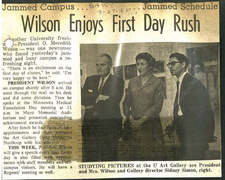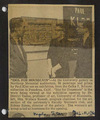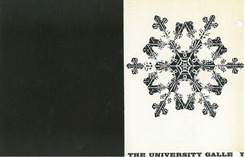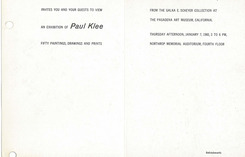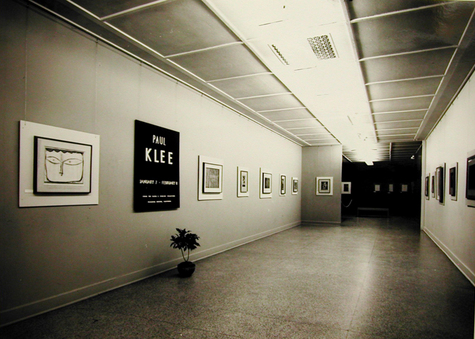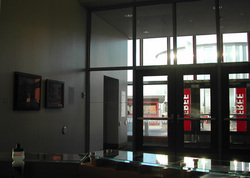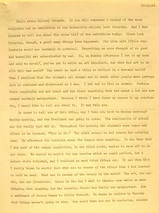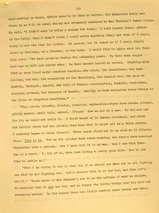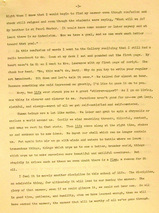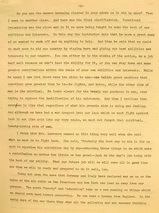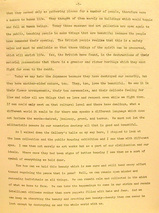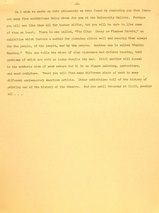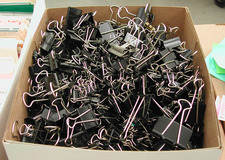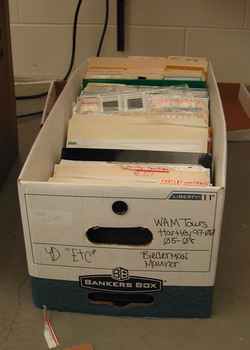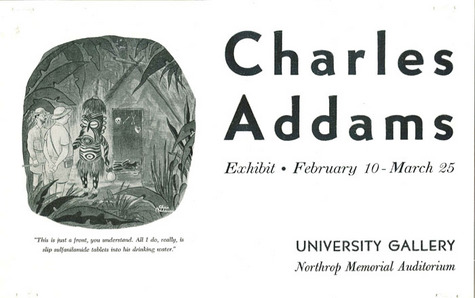Although the WAM Files contain the administrative records of the Weisman Art Museum, it is important to make the distinction that an archival collection may not contain all of the records related to the museum, the exhibits held there, or the artworks in the collection. As we have often referred to other records within the Digital Conservancy and outside collections to provide context to items found within the Files, we must also refer to other records in order to learn more about museum works that are not contained within the archival records.
Such is the case with the work “The Fruit Tree” by Paul Winchell, currently on display in the Davis Gallery at WAM. My eyes have seen thousands of files over the course of the past year and a half and not once have I encountered reference to this work.
Thankfully, WAM tour guide Deborah Shatin, followed the paper trail to other museums and libraries in the Twin Cities to learn more about this work.
In the first of a new series of guest posts on the WAM Files, where we will feature other researchers’ findings on subjects related to WAM, Deborah Shatin shares her investigation of the artist Paul Winchell, and his work “The Fruit Tree.”
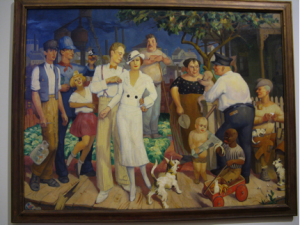
Paul H. Winchell
Information to Date: December 3, 2011
Researched by Deborah Shatin for the WAM
The Weisman Art Museum (WAM) recently installed a painting by Paul H. Winchell with the expansion of the museum space and grand reopening in October 2011. Dated from 1932 it is located in a gallery with the theme of New Deal Gallery with other art works from that time period in our history. Given the varied and unusual figures in this painting, titled “The Fruit Tree,” curiosity arose about the background of the artist and this painting. In culling various sources in the Twin Cities, including the Minneapolis College of Art and Design (MCAD, formerly known as the Minneapolis School of Art), catalogues from the Minneapolis Institute of Arts (MIA), the Minneapolis Central Public Library, the Minnesota Historical Society, and the Hennepin History Museum, the following information was gleaned.
Paul H. Winchell (1903 – 1971) was a printmaker, illustrator, teacher, and gilder according to Crump, 2009 (Minnesota Prints and Printmakers, 1900- 1945, Minnesota Historical Society Press). He was the son of Mrs. Looman Winchell of Shepherd Rd as noted in a 1937 newspaper article (Painsville, O. Telegraph). Winchell grew up in North Perry, Ohio and then studied and worked as an instructor at the Art Institute of Chicago. He studied with Leon Kroll (1884 – 1974), Boris Anisfeld (1878-1973), Daniel Garber (1880 – 1958), Charles Woodbury (1864 – 1940), George Oberteuffer, (1878 – 1940) and Elmer A. Forsberg (1883 – 1950), although it was not stated whether each of these teachers was in Chicago or elsewhere. According to the Minneapolis School of Art Faculty Summer 1930 brochure he was an instructor at the Art Institute of Chicago for three years. According to the 1940 – 1941 catalogue, which provided a short biography and a photograph of the artist, he traveled and studied in Spain, Africa, Italy, England, Germany, and France. According to Crump, Winchell did not receive support from either the Public Works of Art Project or the Minnesota WPA Federal Art Project.
In Minneapolis, where he was an instructor at the Minneapolis School of Art, he first appeared in 1930 in the Minneapolis Institute of Arts’ Sixteenth Annual Exhibition of the Work of Minneapolis and St. Paul Artists, where he exhibited three oil paintings. He received second honorable mention in oil painting for #69 Old Family. In 1931 he received third honorable mention in oil painting for #64, his Portrait of Miss C. Winchell exhibited his work subsequently in other Minneapolis Institute of Arts (MIA) exhibitions in 1933 and 1935 – 1938. According to Crump he also received first prize in the prints category at the Minnesota State Fair in 1940. Other exhibitions included the St. Paul Gallery and School of Art, the Midwestern Artists Association, and the Kansas City Art Institute. His bio at the Minneapolis School of Art also noted he exhibited at the Chicago Art Institute. According to Crump’s summary, based on information from Who Was Who in American Art, 1564-1975 (by Peter Falk), Winchell’s knowledge of gilding as a craft for framing may have provided income supplemental to his teaching.
At the Minneapolis School of Art Winchell taught figure sketching, figure study, elementary illustration, and drawing. His Figure Sketching class in the summer of 1930 is described as follows:
“Rapid sketching from the nude develops a clearness of vision, a quick grasp of essential facts, and a sureness of expression. This class affords an opportunity for study of the figure in action poses which vary in length from one minute to fifty minutes. By making dozens of studies in pencil, crayon, and brush, the student quickly learns to make spirited, rhythmic drawings, based upon a clear understanding. In this class some drawing is done from cast in support o the other work, but the method of approach is the same, and preserves a spontaneity in the results.“
Winchell’s Elementary Illustration course description from the same catalogue states:
“This class work consists of simple illustration problems which require the representation of various objects, such as furniture, simple room interiors, buildings, sometimes in combination with the costumed figure. The theory and practice of perspective and the employment of many decorative treatments in pencil, wash, opaques, and ink, make this a very practical course for those who desire instruction in the elements of drawing as applied to a great variety of subjects. The class work takes the student to the museum galleries and occasionally out of doors for research in connection with the problems assigned.“
The above two course descriptions provide insight into the varied mediums explored by Winchell as well as his emphasis on rapid sketching and the importance of perspective.
According to the Hennepin History Museum (September 22, 2011), Winchell lived at 2416 Dupont Ave So. in 1932 and 4 West 26th St. from 1936 – 1956. In 1946, according to the same source, he was hired as an artist for Brown & Bigelow in St. Paul who typically hired local artists to illustrate calendars with representational art such as hunting scenes. Contacts with Brown & Bigelow were never returned, and a local photographer said that they were not helpful for a different project concerning earlier artistic endeavors at the company. Crump notes that in 1948 Winchell worked at the Cedar Advertising Agency in St. Paul.
From research to date the following institutions in the Twin Cities have at least one art work by Winchell in their collections:
-
- Minneapolis Institute of Arts, 1937, “Rat Anchorage” (drawing)
-
- Minneapolis Central Public Library, Special Collections,
-
- 1934, “Temporary Market at 10th and Hennepin” (etching)
The Special Collections of the Downtown Library has the above etching in their collection, with the librarian stating that this temporary market location was due to a concurrent teamster’s strike. There also is documentation of gifts of this etching in a letter dated December 21, 1935 from the President of Northwestern National Life Insurance Company to the Minneapolis Public Library noting that etchings were being sent as a Christmas greeting. Framed copies of three of the artist’s proofs, printed by the artist, were enclosed. The letter identifies the public library and Baptist Church in the background.
In searching the internet for art work by Paul H. Winchell, a number of items were discovered. These include two nude female images from Ask Art, “Street Mills” dated 1930 and a second landscape/townscape from Heritage Auction Galleries, and a male nude on a blog website (academic painting). As noted earlier, Appendix 1 provides a photograph of the WAM painting by Winchell, apparently listed in the 1933 MIA Exhibition Catalogue as “The Fruit Tree” and dated 1932 by the Minnesota Historical Society.
Bibliography
Robert Crump, Minnesota Prints and Printmakes: 1900 – 1945, Minnesota Historical Society Press, 2009; p175-176.
Peter Falk, Who Was Who in American Art, 1564 – 1975 (cited by Crump)
Who Was Who in American Art, 1903 – 1972, pg 702
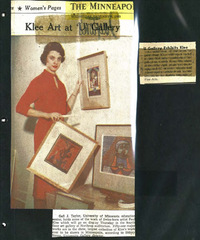 It was more than I expected. Newspaper clippings, photographs, press releases, posters, opening invitations…. oh my! Each binder contained an explosion of ephemera covering exhibits and programming at the University Gallery from approximately 1957-1969. Each piece was neatly placed on pages and covered with clear plastic sheets.
It was more than I expected. Newspaper clippings, photographs, press releases, posters, opening invitations…. oh my! Each binder contained an explosion of ephemera covering exhibits and programming at the University Gallery from approximately 1957-1969. Each piece was neatly placed on pages and covered with clear plastic sheets.